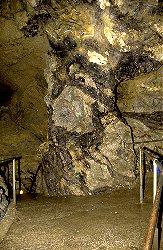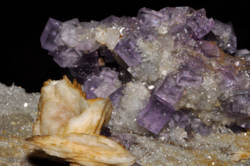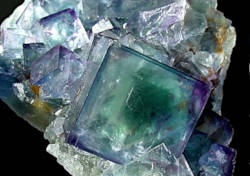Fluorite Mines

 Treak Cliff Cavern & Mine and other caves around
Treak Cliff Cavern & Mine and other caves around  Castleton.
Castleton.

Fluorite (CaF2) or fluorspar is a halide mineral composed of calcium and fluor. It is found in various different colours including colorless, white, purple, blue, green, yellow, orange, red, pink, brown, and bluish black. Actually it has been dubbed the most colorful mineral in the world. Most common are purple, blue and green, and the mineral is commonly zoned. The spar part of the name is a result of its tendency to form plain surfaces when it is broken.
Fluorite is used in indutrial processes like smelting and glass production. It lowers the melting point which saves energy. It increases the fluidity of slags used in smelting flux, a property which actually gave the mineral its name. Fluorite is derived from the Latin root fluo, meaning to flow. Fluor is also needed for toothpaste and for the production of chlorofluorocarbon (CFC). Actually this last group of substances, which was used for refrigerators and dry cleaning, and as aerosol in spray units, is now banned because it destroys the ozone layer. Fluor is also needed for plasic and rocket fuel. And, with the right colour and banding fluorite is used for jewelry, regarded a semi-precious stone. It is also used for other items like bowls or vases. And the minerals are very popular with mineral collectors.
Fluorite is widely occurring as a primary mineral in granites and other igneous rocks. It is also a common minor constituent of dolostone and limestone. But both occurances are of little economic interest, as the amount is very low. Fluorite is mined solely from hydrothermal veins or gangues, typically found around granite. Granite intrusions, where the granite contains fluoride, also start to heat the surrounding rock and the groundwater. The thermal water form convection cells which transport material dissolved from the rock to clefts created by the tectonic forces of the intrusion. The resulting veins or gangues may contain various different minerals. Fluorite veins commonly also contain baryte (BaSO4), calcite, dolomite, pyrite, markasite, sphalerite, galena, chalkopyrite, and uranium.
Mining actually has to follow the veins. Such veins may differ widely in their thickness, so it may be necessary to follow a closed vein for some distance until it reopens. The medieval German miners greeting is Glück auf (luck up), which is often interpreted as be lucky and return to the surface as auf means up. Actually it also means be lucky and the vein opens as auf can also mean to widen or open.
 Search DuckDuckGo for "Fluorite Mines"
Search DuckDuckGo for "Fluorite Mines" Fluorite - Wikipedia (visited: 22-MAY-2011)
Fluorite - Wikipedia (visited: 22-MAY-2011) Fluorite: Fluorite mineral information and data. (visited: 22-MAY-2011)
Fluorite: Fluorite mineral information and data. (visited: 22-MAY-2011)
 Index
Index Topics
Topics Hierarchical
Hierarchical Countries
Countries Maps
Maps